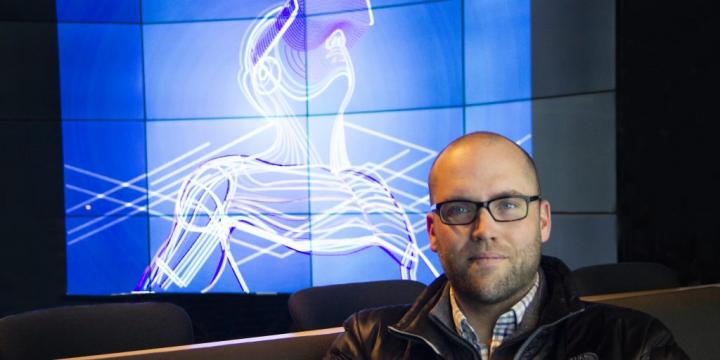
Credit: School of Informatics and Computing
Zebulun Wood, lecturer and co-director of the undergraduate Media Arts and Science program, will lead a team from the School of Informatics and Computing at IUPUI as part of a $1.6 million NIH R61 Phase 1 Exploratory/Development Grant recently awarded to Tom Hummer, assistant research professor of psychiatry at the Indiana University School of Medicine.
The investigation will examine whether virtual reality can improve perspective taking and related brain function and behavior in youth with oppositional defiant disorder (ODD) or conduct disorder (CD). If successful, an additional three years of funding may be received during the R33 phase for a five-year grant total of $4.06M.
Children and adolescents with ODD or CD, collectively knows as disruptive behavioral disorders (DBDs), often have difficulties with social perspective taking that contribute to poor empathy, disruptive behaviors, and aggression.
Therefore, interventions that can help their perspective taking may be able to increase empathy and improve behavior.
In Hummer and Wood’s proposal, this investigation of youth with DBDs will use advanced VR technology to provide alternate perspectives of an interpersonal conflict, and provide valuable information regarding the potential for VR to be integrated into therapeutic strategies with this population.
“VR has exciting potential as a therapeutic tool to address perspective-taking deficits because it can provide natural environments in which users can easily experience social interactions from multiple viewpoints.”
In the R61 phase, participants will experience interpersonal conflicts via VR and answer questions regarding their ability to understand a virtual counterpart’s perspective.
Participants will then experience scenarios from the virtual counterpart’s point-of-view, in a more immersive manner than imagination or role-playing would provide. Wood and selected students from the School of Informatics and Computing will create multiple scenarios that children might experience in the real world, such as in a school cafeteria, classroom, or living room.
“We want to create situations that kids really live through, so they can better understand all sides of the interactions they have every day,” says Hummer.
Wood says, “The Media Arts and Science students’ skills acquired from the 3D animation and game design and development specializations are perfectly aligned to create these empathy training exercises for the study. With positive data, there is a large promise to expand the use of VR in mental health domains such as meditation or phobias, or PTSD. These media arts and sciences skill-sets are far more valuable and accessible outside of the entertainment industry than ever before.”
The study will also measure brain activity via MRI, which will be compared to a baseline taken prior to exposure.
The goal is to determine how well the VR programs affect thoughts and brain activity related to perspective taking, so the team has a better idea about how to incorporate VR into mental health treatment.
Hummer says, “Disruptive behavior disorders are costly to families and society, but effective treatments are often tricky to implement. We’re hoping VR can expand the toolset for clinicians and families, addressing these behavior problems in a way that is innovative and engaging.”
Wood and Hummer’s investigation will proceed to the R33 phase if milestone criteria are met for engagement of both psychological and neural targets. Their work can confirm the potential for VR to be used to help improve perspective taking and poor social-cognitive skills in youth with DBDs and will lay the foundation for assessing whether VR tools can improve DBD symptoms as a stand-alone program or adjunct to clinical treatment.
Hummer says he has been “very impressed by the work of the MAS students, so I’m excited to continue our collaboration. The field of psychiatry can benefit immensely from new digital media tools, so this relationship has a lot of potential moving forward, especially within the realm of mental health.”
###
About Zebulun Wood
Zeb Wood’s comfort zone is at the edge of emerging media, focusing in 3D design integrated formats. He has worked with students on projects that improve lives and disrupt industries, and instructs in all areas of 3D production, including augmented and virtual reality. Throughout his teaching and volunteer efforts, Wood continues to seek collaboration. He is currently leading projects that explore the use of augmented reality, 3D and 3D printing in prosthetic design, augmented reality in education, and education for innovation and entrepreneurial thinking.
About Tom Hummer
Tom Hummer received his Ph.D. in computational neuroscience from the University of Chicago, and joined the IU School of Medicine Department of Psychiatry in 2009. At IUSM, he joined a team using neuroimaging to examine how media violence exposure affects the brain. Since that time, he has utilized neuropsychological, behavioral, and neuroimaging tools to examine how different forms of digital media use impact brain structure and function, particularly during childhood and adolescence. He also employs neuroimaging to examine adolescent risky decision-making in areas such as substance use and sexual behavior.
About NIH R61 Phase 1 Exploratory/Developmental Grant
An NIH R61 is a Phase 1 Exploratory/Developmental Grant funding mechanism for preliminary data to be obtained within the first two years of an overall 5-year R33 project. Research reported in this publication was supported by the National Institute of Mental Health of the National Institutes of Health under award number 1R61MH119291-01. Total program or project costs of $1,622,677 are financed with federal money. The content is solely the responsibility of the authors and does not necessarily represent the official views of the National Institutes of Health.
Media Contact
Rich Schneider
[email protected]
Original Source
https:/



